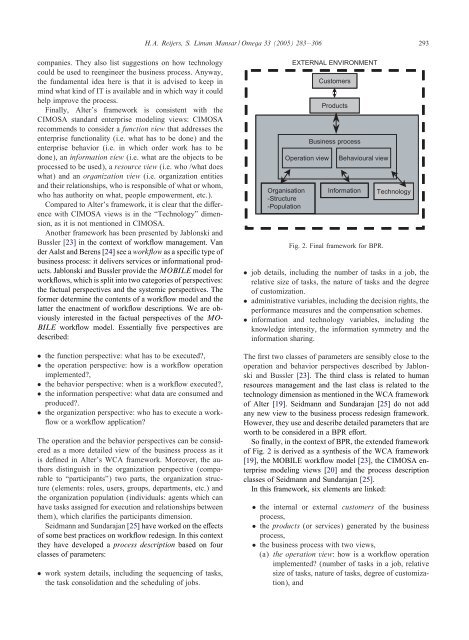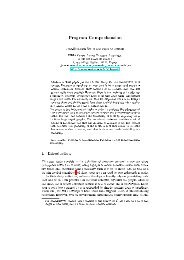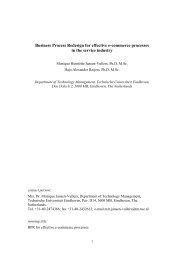Best practices in business process redesign: an overview and ...
Best practices in business process redesign: an overview and ...
Best practices in business process redesign: an overview and ...
You also want an ePaper? Increase the reach of your titles
YUMPU automatically turns print PDFs into web optimized ePapers that Google loves.
comp<strong>an</strong>ies. They also list suggestions on how technology<br />
could be used to reeng<strong>in</strong>eer the bus<strong>in</strong>ess <strong>process</strong>. Anyway,<br />
the fundamental idea here is that it is advised to keep <strong>in</strong><br />
m<strong>in</strong>d what k<strong>in</strong>d of IT is available <strong>an</strong>d <strong>in</strong> which way it could<br />
help improve the <strong>process</strong>.<br />
F<strong>in</strong>ally, Alter’s framework is consistent with the<br />
CIMOSA st<strong>an</strong>dard enterprise model<strong>in</strong>g views:CIMOSA<br />
recommends to consider a function view that addresses the<br />
enterprise functionality (i.e. what has to be done) <strong>an</strong>d the<br />
enterprise behavior (i.e. <strong>in</strong> which order work has to be<br />
done), <strong>an</strong> <strong>in</strong>formation view (i.e. what are the objects to be<br />
<strong>process</strong>ed to be used), a resource view (i.e. who /what does<br />
what) <strong>an</strong>d <strong>an</strong> org<strong>an</strong>ization view (i.e. org<strong>an</strong>ization entities<br />
<strong>an</strong>d their relationships, who is responsible of what or whom,<br />
who has authority on what, people empowerment, etc.).<br />
Compared to Alter’s framework, it is clear that the di erence<br />
with CIMOSA views is <strong>in</strong> the “Technology” dimension,<br />
as it is not mentioned <strong>in</strong> CIMOSA.<br />
Another framework has been presented by Jablonski <strong>an</strong>d<br />
Bussler [23] <strong>in</strong> the context of work ow m<strong>an</strong>agement. V<strong>an</strong><br />
der Aalst <strong>an</strong>d Berens [24] see a work ow as a speci c type of<br />
bus<strong>in</strong>ess <strong>process</strong>:it delivers services or <strong>in</strong>formational products.<br />
Jablonski <strong>an</strong>d Bussler provide the MOBILE model for<br />
work ows, which is split <strong>in</strong>to two categories of perspectives:<br />
the factual perspectives <strong>an</strong>d the systemic perspectives. The<br />
former determ<strong>in</strong>e the contents of a work ow model <strong>an</strong>d the<br />
latter the enactment of work ow descriptions. We are obviously<br />
<strong>in</strong>terested <strong>in</strong> the factual perspectives of the MO-<br />
BILE work ow model. Essentially ve perspectives are<br />
described:<br />
• the function perspective:what has to be executed?,<br />
• the operation perspective:how is a work ow operation<br />
implemented?,<br />
• the behavior perspective:when is a work ow executed?,<br />
• the <strong>in</strong>formation perspective:what data are consumed <strong>an</strong>d<br />
produced?.<br />
• the org<strong>an</strong>ization perspective:who has to execute a workow<br />
or a work ow application?<br />
The operation <strong>an</strong>d the behavior perspectives c<strong>an</strong> be considered<br />
as a more detailed view of the bus<strong>in</strong>ess <strong>process</strong> as it<br />
is de ned <strong>in</strong> Alter’s WCA framework. Moreover, the authors<br />
dist<strong>in</strong>guish <strong>in</strong> the org<strong>an</strong>ization perspective (comparable<br />
to “particip<strong>an</strong>ts”) two parts, the org<strong>an</strong>ization structure<br />
(elements:roles, users, groups, departments, etc.) <strong>an</strong>d<br />
the org<strong>an</strong>ization population (<strong>in</strong>dividuals:agents which c<strong>an</strong><br />
have tasks assigned for execution <strong>an</strong>d relationships between<br />
them), which clari es the particip<strong>an</strong>ts dimension.<br />
Seidm<strong>an</strong>n <strong>an</strong>d Sundaraj<strong>an</strong> [25] have worked on the e ects<br />
of some best <strong>practices</strong> on work ow <strong>redesign</strong>. In this context<br />
they have developed a <strong>process</strong> description based on four<br />
classes of parameters:<br />
• work system details, <strong>in</strong>clud<strong>in</strong>g the sequenc<strong>in</strong>g of tasks,<br />
the task consolidation <strong>an</strong>d the schedul<strong>in</strong>g of jobs.<br />
H.A. Reijers, S. Lim<strong>an</strong> M<strong>an</strong>sar / Omega 33 (2005) 283 – 306 293<br />
Operation view i Behavioural i lview<br />
Org<strong>an</strong>isation<br />
-Structure<br />
-Population<br />
EXTERNAL ENVIRONMENT<br />
Customers<br />
Products<br />
Bus<strong>in</strong>ess <strong>process</strong><br />
Information Technology<br />
Fig. 2. F<strong>in</strong>al framework for BPR.<br />
• job details, <strong>in</strong>clud<strong>in</strong>g the number of tasks <strong>in</strong> a job, the<br />
relative size of tasks, the nature of tasks <strong>an</strong>d the degree<br />
of customization.<br />
• adm<strong>in</strong>istrative variables, <strong>in</strong>clud<strong>in</strong>g the decision rights, the<br />
perform<strong>an</strong>ce measures <strong>an</strong>d the compensation schemes.<br />
• <strong>in</strong>formation <strong>an</strong>d technology variables, <strong>in</strong>clud<strong>in</strong>g the<br />
knowledge <strong>in</strong>tensity, the <strong>in</strong>formation symmetry <strong>an</strong>d the<br />
<strong>in</strong>formation shar<strong>in</strong>g.<br />
The rst two classes of parameters are sensibly close to the<br />
operation <strong>an</strong>d behavior perspectives described by Jablonski<br />
<strong>an</strong>d Bussler [23]. The third class is related to hum<strong>an</strong><br />
resources m<strong>an</strong>agement <strong>an</strong>d the last class is related to the<br />
technology dimension as mentioned <strong>in</strong> the WCA framework<br />
of Alter [19]. Seidm<strong>an</strong>n <strong>an</strong>d Sundaraj<strong>an</strong> [25] do not add<br />
<strong>an</strong>y new view to the bus<strong>in</strong>ess <strong>process</strong> <strong>redesign</strong> framework.<br />
However, they use <strong>an</strong>d describe detailed parameters that are<br />
worth to be considered <strong>in</strong> a BPR e ort.<br />
So nally, <strong>in</strong> the context of BPR, the extended framework<br />
of Fig. 2 is derived as a synthesis of the WCA framework<br />
[19], the MOBILE work ow model [23], the CIMOSA enterprise<br />
model<strong>in</strong>g views [20] <strong>an</strong>d the <strong>process</strong> description<br />
classes of Seidm<strong>an</strong>n <strong>an</strong>d Sundaraj<strong>an</strong> [25].<br />
In this framework, six elements are l<strong>in</strong>ked:<br />
• the <strong>in</strong>ternal or external customers of the bus<strong>in</strong>ess<br />
<strong>process</strong>,<br />
• the products (or services) generated by the bus<strong>in</strong>ess<br />
<strong>process</strong>,<br />
• the bus<strong>in</strong>ess <strong>process</strong> with two views,<br />
(a) the operation view:how is a work ow operation<br />
implemented? (number of tasks <strong>in</strong> a job, relative<br />
size of tasks, nature of tasks, degree of customization),<br />
<strong>an</strong>d






